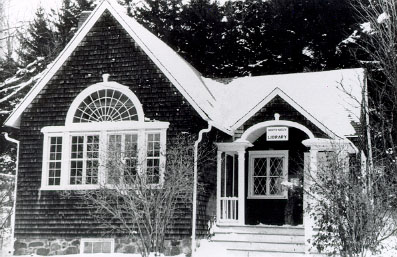History
North Hatley Library
Tradition relates that the Library began in 1896, in the form of young ladies taking books around in baskets! There exist minutes and financial records of the Library dating from 1898, and the incorporation of the Library took place in 1901. Its first fixed location was above the grocery store. In 1904 money was raised, land donated, a New York architect engaged and a library building erected.
The building has been enlarged twice since. In 1967 as a Centennial project, a children’s wing was added, and in 1986 a further extension was built and the existing building entirely renovated. This last expansion was made possible by a substantial legacy from a New York woman who spent a lot of time in North Hatley and supported many village projects. The legacy has also made a part-time employee possible.
Background

To understand the history of the North Hatley Library, a little must be said of the village it serves. North Hatley was ‘discovered’ as a summer resort at the end of the last century. The first summer residents were Americans from the Southern States who wanted to escape the heat but were reluctant to spend time among the Yankees of the North. Feelings still ran high after the American Civil War. These first summer residents had the time and the means and the American traditions that made a Library a priority.
Another feature of North Hatley is the number of authors it has nourished. Over the years, the bibliography of ‘local published authors’ has increased considerably. In its first days, it included Roland Giguère, Gérard Godin, D. G. Jones, Hugh MacLennan and Frank R. Scott. More recently, Robert Lalonde along with NY Times best-sellers Anne Fortier and Alison Pick have joined the list. With North Hatley local authors having garnered eleven Governor General’s awards, a Pulitzer prize and a long list of numerous other awards, how could it not have a wonderful library?
The Library Today

The Library is managed by a board of directors, and day-to-day operations are handled by one part-time employee (20 hours a week) and many volunteers. It receives no help from any level of government and is funded by the interest from the legacy and other donations, as well as the yearly subscriptions.
The population of the village of North Hatley is around 650 in winter, and double that in summer. The Library also serves people in the surrounding Township of Hatley (pop. 2 000), as well as some families in the nearby communities of Hatley, Ayer’s Cliff and Sainte-Catherine-de-Hatley. North Hatley Library is particularly attractive to Anglophones, as it offers one of the largest and most diverse English collections in the region.
The collection consists of 20,000 documents, of which 4,000 are for children. About a thousand new books are added each year, including French, English and Large Print. In view of the increasing Francophone population that we serve in the region, the board of the library has made it a priority to expand and improve our French collection. The library is tapped into a vast provincial network of libraries, allowing us to access tens of thousands of titles through our inter-library loan service. In summer there are children’s story hours in French and English, and special events are scheduled throughout the year.
Adult membership in the Library costs $25 a year, or $30 for a family. The Library is open 17 hours a week (19.5 in summer), including Saturday morning and Wednesday evening.
When the Library was expanded, space was planned for art exhibitions. These have proven to be very popular. Every winter, we also host a Winter Gift show featuring high-quality art and craft products from local artists and artisans.
The Library has two computers for public use and Wi-fi is offered freely. There is also a printer and photocopier.
The North Hatley Library is a gem. The people of North Hatley have had imagination, talent, time and money, and have used them generously over the years to produce a beautiful and well-equipped library which does its best to serve the community.
Based on an article written by Susan Gwyn that originally appeared in Défi: Revue de l’Association des directeurs de bibliothèques publiques du Québec, vol. 6 no. 3, décembre 1991.